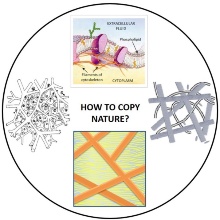Gelled Complex Fluids are soft materials in which the microstructure of the complex fluid is combined with the mechanical stability of a gel, which makes them an interesting candidate in (trans-)dermal drug delivery or tissue healing applications. The most prominent example of a “natural” gelled complex fluid is the cell. One strategy to form gelled complex fluids is orthogonal self-assembly, i.e. the independent but simultaneous formation of two coexisting structures. In order to study orthogonal self-assembly, we chose the system H2O – n-decane – tetraethylene glycol monododecyl ether (C10E4) and gelled both the bicontinuous microemulsion and the lamellar phase of the very same system with the low molecular weight gelator 12‑hydroxyoctadecanoic acid (12‑HOA). The non-gelled and gelled systems were then characterized by measuring phase diagrams, rheology, and SANS, as well as by taking TEM pictures. We identified gelled bicontinuous microemulsions as orthogonal self-assembled systems in which the nanostructured microemulsion coexists independently with the gel network. We also found that the lamellar phase coexists with a gel network by visual observations, 2H-NMR, rheology, and TEM but the question whether or not they form independently still has to be answered.


